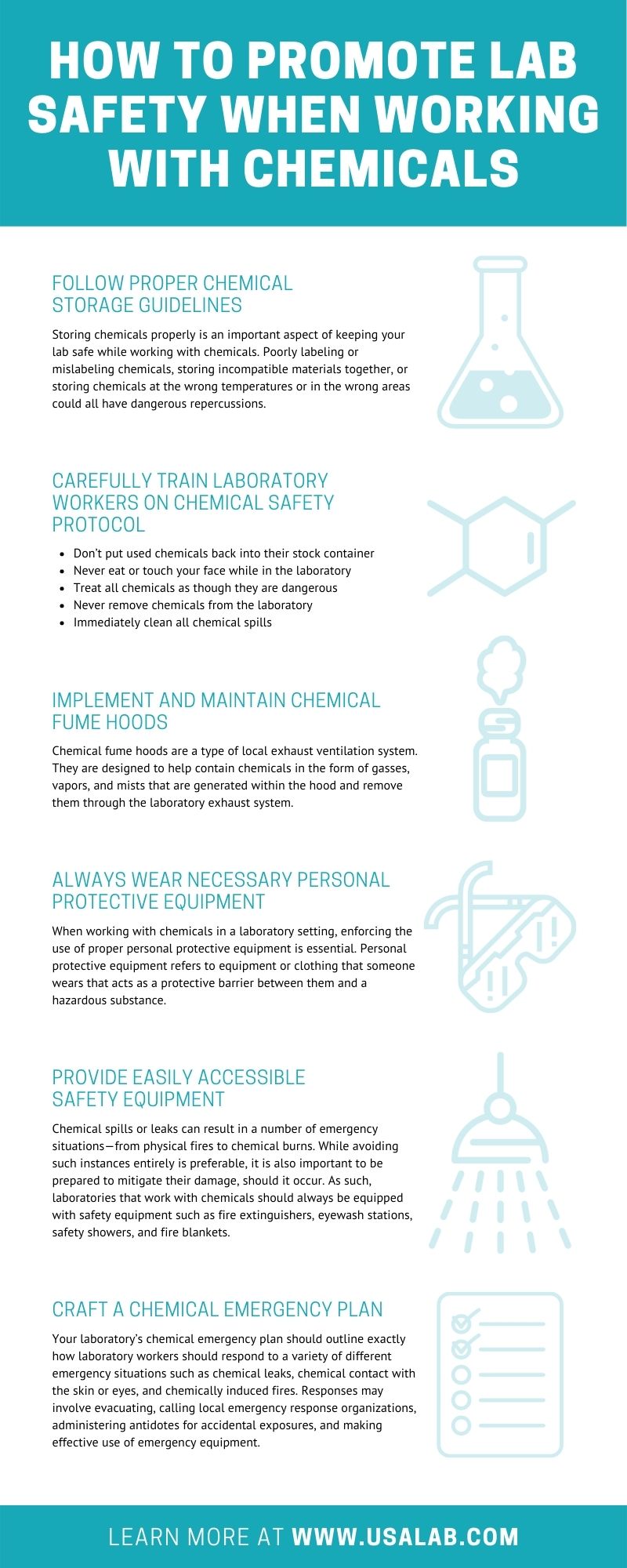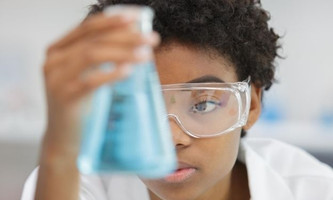How to Promote Lab Safety When Working with Chemicals
Jul 29th 2020
The use of chemicals is essential in nearly all types of laboratories. While often necessary, using chemicals poses several health and safety risks for laboratory staff as a result of gas leaks, chemical spills, and dangerous reactions that result in fires and harmful fumes. Due to these risks, it is important to take extra precautions when working with chemicals in a laboratory to avoid hazardous exposure or other repercussions that could threaten the health and safety of laboratory staff. Here are some helpful tips on how to promote lab safety when working with chemicals.
Follow proper chemical storage guidelines
Storing chemicals properly is an important aspect of keeping your lab safe while working with chemicals. Poorly labeling or mislabeling chemicals, storing incompatible materials together, or storing chemicals at the wrong temperatures or in the wrong areas could all have dangerous repercussions.
Labeling chemicals
Labeling chemicals will help prevent accidentally mixing incorrect chemicals together or using expired chemicals which can result in dangerous reactions. As such, it is important to carefully label every container that contains chemicals before putting it into storage. When labeling chemicals, make sure to be as detailed as possible.
The label should include information regarding what the chemical is, its expiration date, the potential risks that the chemical poses, and any other pertinent data. To ensure that such detailed information is easily legible, it’s also crucial to use a chemical-resistant label, as general-use paper labels can peel off or become distorted.
Incompatible chemicals
Storing incompatible chemicals together will often result in dangerous, unintended reactions. As such, it is important to separate chemicals into different chemical storage cabinets or containment trays based on compatible groups when storing them. If you are storing incompatible compressed gas cylinders, take extra care to separate them using either a separation barrier or a significant amount of distance.
To prevent laboratory workers from accidentally storing incompatible chemicals together, it is a good idea to keep a chemical compatibility chart posted in the lab as well as storage rooms for reference. Examples of incompatible chemicals include:
- strongly oxidizing substances and oxidizable substances
- flammable/ combustible liquids and acids/oxidizers
- Acids and bases
- Acids and reactive metals
- Strong acids and organic substances
Chemical storage conditions
Proper storage conditions will vary greatly depending on the type of chemical being stored. For example, if a chemical is toxic or volatile, it must be stored in a ventilated cabinet, while ethers and peroxide-building chemicals need to be stored in tightly-sealed containers. Before storing a chemical, it is important to check with your health and safety personnel and local municipal authority to ensure that you are adhering to proper storage guidelines.
Carefully train laboratory workers on chemical safety protocol
To promote lab safety when working with chemicals, it is important to ensure that all laboratory staff are well-versed in basic chemical safety protocol. Examples of essential safety rules that should be enforced in all laboratories that work with chemicals include:
- Don’t put used chemicals back into their stock container
- Wash your hands with soap and water promptly after conducting an experiment that involved chemicals
- Never eat or touch your face while in the laboratory
- Treat all chemicals as though they are dangerous
- Never remove chemicals from the laboratory
- Immediately clean all chemical spills
- Carefully read all labels before removing the contents of a chemical container
Implement and maintain chemical fume hoods
Chemical fume hoods are a type of local exhaust ventilation system. They are designed to help contain chemicals in the form of gasses, vapors, and mists that are generated within the hood and remove them through the laboratory exhaust system. In doing so, chemical fume hoods effectively protect laboratory workers from inhaling or being exposed to harmful chemicals. When working with flammable or volatile chemicals, the use of a chemical fume hood is essential.
Always wear necessary personal protective equipment
When working with chemicals in a laboratory setting, enforcing the use of proper personal protective equipment is essential. Personal protective equipment refers to equipment or clothing that someone wears that acts as a protective barrier between them and a hazardous substance.
Examples of necessary personal protective equipment for chemical labs may include protective gloves, safety goggles, laboratory coats, respirators, splash shields, and close-toed shoes. Laboratory workers should wear such equipment at all times when working with chemicals to protect them from harmful chemical contact or exposure.
Provide easily accessible safety equipment
Chemical spills or leaks can result in a number of emergency situations—from physical fires to chemical burns. While avoiding such instances entirely is preferable, it is also important to be prepared to mitigate their damage, should it occur. As such, laboratories that work with chemicals should always be equipped with safety equipment such as fire extinguishers, eyewash stations, safety showers, and fire blankets. Such safety equipment should be kept in an area that is easily accessible so that lab personally can access them quickly in time-sensitive emergency situations.
Craft a chemical emergency plan
In addition to providing your laboratory with essential equipment that is suited for common chemical emergency situations, it is also important to have an emergency plan. After all, having proper equipment won’t do much good unless your staff knows how to operate it effectively and efficiently.
Your laboratory’s chemical emergency plan should outline exactly how laboratory workers should respond to a variety of different emergency situations such as chemical leaks, chemical contact with the skin or eyes, and chemically induced fires.
Responses may involve evacuating, calling local emergency response organizations, administering antidotes for accidental exposures, and making effective use of emergency equipment. In any case, it is important for lab staff to know exactly how to respond to a given circumstance so that they can act immediately in time-sensitive situations.
If the applications of your laboratory involve the use of chemicals, USA Lab Equipment can provide you with the necessary safety and storage equipment that you require. From chiller lab equipment to 100ML-10,000ML storage bottles, our extensive stock of laboratory equipment includes a wide variety of new and used equipment at competitive prices. For more information regarding our high-quality equipment or for help determining which type of equipment is the best fit for your lab, contact USA Lab Equipment today.


